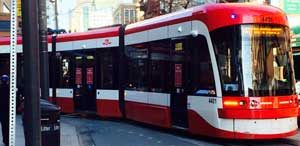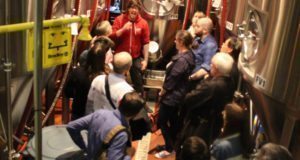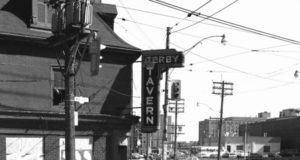Eric Morse —
On July 7, a public consultation between the Cabbagetown South Residents’ Association and 51 Division Community Liaison took place at Central Neighbourhood House, moderated by Deputy Mayor Pam McConnell and including representatives from Fire Services. It was somewhat fraught, as meetings of this nature tend to be, but left little doubt that the area between Parliament, Gerrard, Sherbourne and Shuter is suffering from a major recent upswing in street nuisance—principally drug use and prostitution—in the area immediately westward of the redeveloped Regent Park.
Residents noted that the problems are greatest in the laneways off Parliament and Berkeley—speakers emphasized Drover’s Lane, Calgie Lane, Callaghan Lane, and Poulett St.—and the sentiment in the room was that the recent increase in problems seemed to coincide with the decline in oral drug usage (crack, Oxycontin) and an upsurge in heroin cut with Fentanyl, which requires needles.
One police officer noted to The Bulletin that the problems “have been moving slowly south for years.” Four needle exchanges exist in the area but do not seem (in area residents’ view) to be making much of a dent in the problem.
Specific complaints centered around the sense of impunity that the johns and hookers have begun showing, to the point of intimidating residents and homeowners. The accumulation of condoms and needles (and vandalism) in the laneways (and in Lord Dufferin schoolyard) was pointed to as a major irritant. Much of the discussion focused on a single-owner block of properties at Dundas and Parliament which seems to be a focus of trafficking.
There was also reference to the use of a laneway (rear) entrance to a social service agency slightly farther south which McConnell said her office would look into.
An occasionally frustrated discussion on deterrence took place. As one resident expressed it, do-it-yourself solutions like exterior floodlights are a lose-lose situation—”if you turn them off, it’s condoms, if you turn them on, it’s needles.”
Dundas St. resident Dennis Findlay favoured the use of phone cameras to deter the more aggressive prostitutes; police representatives conceded that this could be effective but could also be dangerous and urged caution. Fire and health inspections were also mentioned as a tool for deterrence where policing is frustrated (given that prostitution itself is not a criminal offense).
The consensus seemed to be that a heavier foot patrol presence was needed; a police representative agreed with the principle but also commented to The Bulletin that resources are not getting greater and the new residential districts opening up south of Corktown are going to lead to an increased demand. McConnell told the meeting that since amalgamation, there have been noticeable cuts to the budgets for laneway maintenance—”there aren’t 23 votes for lanes.”
She committed to a monthly cleanup of lanes by Solid Waste, with more as necessary.
51 Division urged residents not to give up on reporting, even if it seems that any single call does not get much of a response – “you know what they say about squeaky wheels.”
Representatives also urged complainants to call 51 Division Community Liaison at (416) 808-2222 rather than 911. They noted that a free street safety audit of properties is available from the Division. There is also a handy fridge card of whom to call about what, published by the four Downtown BIAs (Yonge St., St Lawrence, Cabbagetown and Church-Wellesley Village) available from the BIA offices.
Essential 51 Division contacts: (416) 808-5100 or 2222. Twitter @TP551Div. Facebook: 51 Division – Toronto Police.
 TheBulletin.ca Journal of Downtown Toronto
TheBulletin.ca Journal of Downtown Toronto


